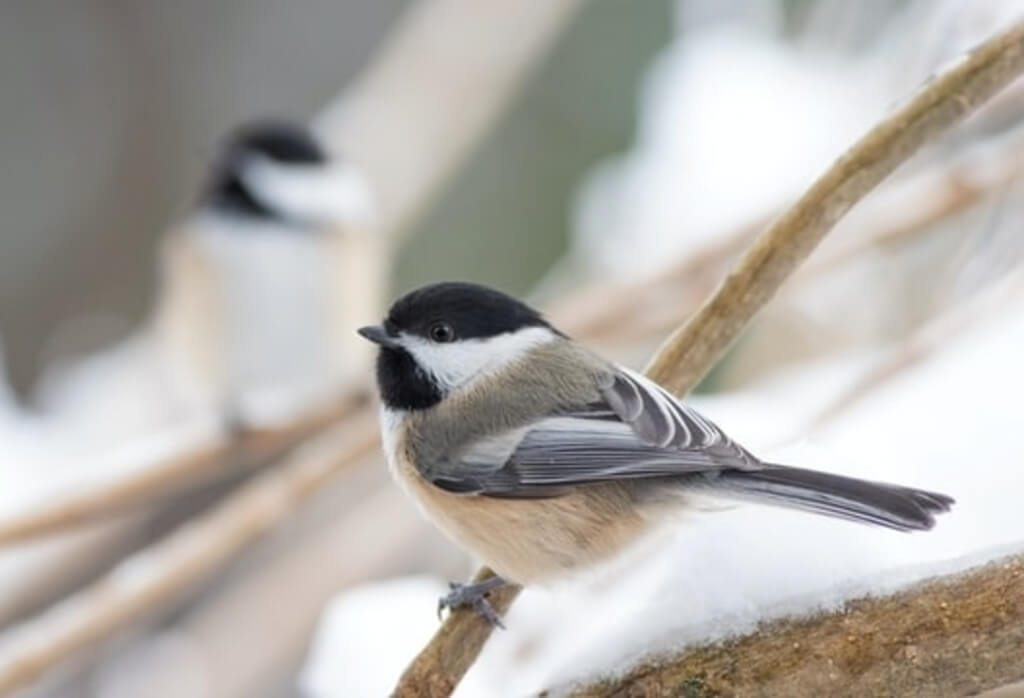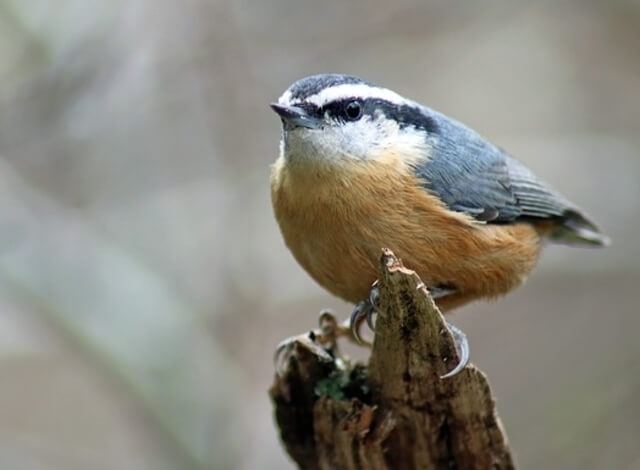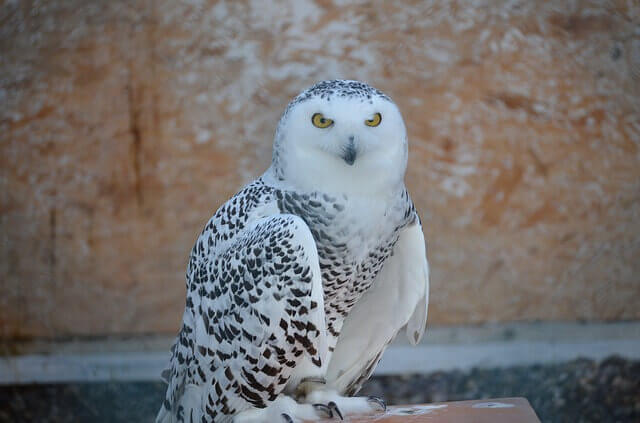Prepare to embark on a mesmerizing journey to the heart of chilly landscapes as we venture into the captivating world of 12 Birds That Live in Cold Climates. In this immersive expedition, we’ll uncover the extraordinary stories of these feathered residents, their unique adaptations, and the delicate balance they maintain in their frigid habitats.
Table of Contents
Snow Bunting
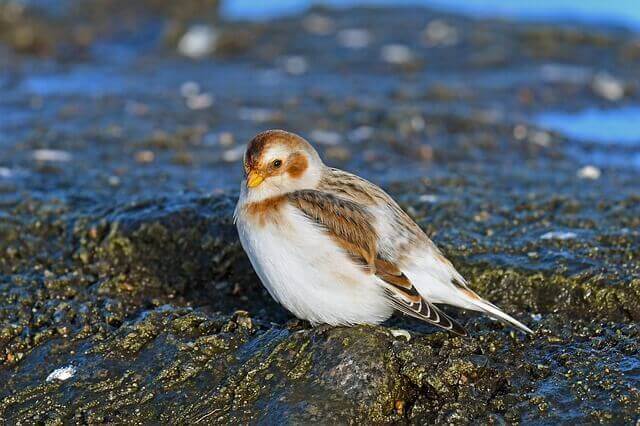
| Characteristic | Description |
|---|---|
| Identification | Winter plumage is mostly white, with a reddish-brown head and back, with a yellow bill, white inner wings with black wingtips. |
| Length | 5.9 inches (15 cm) |
| Weight | 1.1-1.6 ounces (31-46 grams) |
| Wingspan | 11.8 inches (30 cm) |
Snow Bunting is a rare bird that has adapted to live in very cold environments. It is found in the Arctic regions of North America and Eurasia, but its range extends southwards to include northern Canada, Alaska and Scandinavia.
They are also sometimes seen in some mountainous areas of the southern United States during winter. Their habitat ranges from treeless tundra near sea level up to treeless alpine meadows at an altitude of about 4500 meters (14,800 feet).
They prefer to nest on high ground and near water sources such as streams or ponds, so they have access to food and water throughout the year.
Snow Buntings are hard to spot due to their coloration; they blend into the tundra like chameleons do with trees. They feed on insects, seeds and berries during the summer months, but will turn to seeds and fruit during winter months when food sources become scarce.
How to Attract Snow Buntings in Winter:
- Provide a mix of seeds (millet, sunflower seeds, cracked corn).
- Scatter seeds on the ground or use low feeders.
Dark-eyed Junco
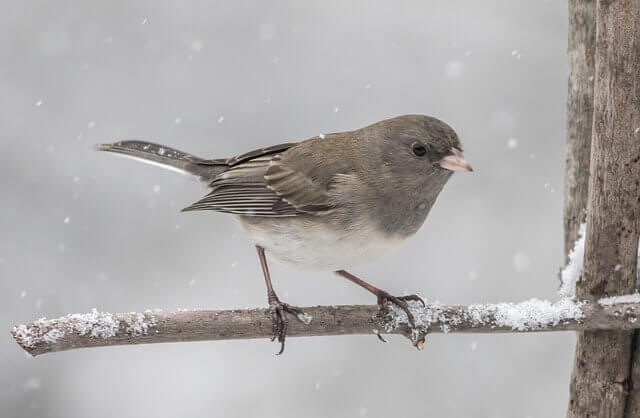
| Characteristic | Description |
|---|---|
| Identification | The Dark-eyed Junco has a dark gray head, neck, and chest with a white lower belly, and a short light pink conical bill. |
| Length | 5.1-6.6 inches (13-17 cm) |
| Weight | 0.6-1.0 ounces (17-31 grams) |
| Wingspan | 6.6-10.2 inches (17-26 cm) |
The Dark-Eyed Junco is a small bird found in colder climates throughout North America. It has the most northerly range of any songbird species living within the contiguous United States.
Its range extends from the eastern coast of Canada to Texas and New Mexico, as well as parts of Alaska. They live year round in Colorado, Wyoming, Montana, Idaho and Washington.
They can be found living in shrubs, thickets, dense forests and mountain meadows at an elevation up to 12000 feet above sea level. Their diet consists mostly of insects, worms, spiders and seeds, but it also includes some berries and green plants during summer months.
They are often found near human settlements where they find food scraps on the ground or gardens to forage from during breeding season.
How to Attract Dark-eyed Juncos in Winter:
- Offer a variety of seeds (millet, sunflower seeds, cracked corn).
- Use ground feeders or platform feeders near shrubs or trees.
Black-capped Chickadee
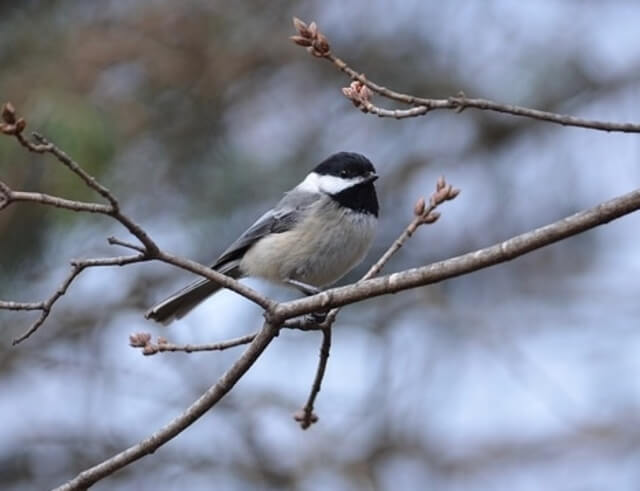
| Characteristic | Description |
|---|---|
| Identification | The Black-capped Chickadee has a black cap with white cheek patches, black eyes, grayish-brown back, wings, and tail feathers with a white belly. |
| Length | 4.5-6.0 inches (12-15 cm) |
| Weight | 0.32–0.49 ounces (10-15 grams) |
| Wingspan | 6.3-8.3 inches (16-21 cm) |
The Black-capped Chickadee is a small, non-migratory songbird that breeds in the United States and Canada. In North America, it inhabits the boreal forests of Alaska, Canada and Maine south through New England, Michigan’s Upper Peninsula and Appalachia as far west as Texas.
Its habitat ranges from dense forest, scrubby brushland, wet meadows to open deciduous woods with an understory of shrubs or vines. They feed primarily on insects, spiders, worms and other invertebrates found in leaves or soil; occasionally it will also eat seeds and berries.
They are very active birds during winter, spending their days gathering food on the ground beneath trees, searching under leaf litter for insects and invertebrates. Furthermore, they use their long claws to help them dig out prey from bark crevices of live trees.
How to Attract Black-capped Chickadees in Winter:
- Supply sunflower seeds, peanuts, and suet in hanging feeders.
- Ensure fresh water in a heated birdbath.
Red-breasted Nuthatch
| Characteristic | Description |
|---|---|
| Identification | Red-breasted Nuthatches are bluish-gray birds with a black cap and black stripe over the eye. The throat is white, and the breast and belly are rich rusty-cinnamon, with females being slightly paler. |
| Length | 4.3 inches (11 cm) |
| Weight | 0.3-0.5 ounces (8-13 grams) |
| Wingspan | 7.1-7.9 inches (18-20 cm) |
The Red-breasted Nuthatch is a small, insectivorous bird found in North America. It prefers to live near open woodlands deciduous forests, rural farmlands, and suburban areas and can be found as far north as Alaska and as far south as the high mountains of Mexico.
In the western part of its range it is most common at higher elevations, but on occasion can be seen at lower elevations or near human habitation where food sources are abundant. The range of these birds is more expansive than other nuthatch species because they can survive in colder temperatures due to their nesting habits, which help insulate them from cold weather.
They live in nest cavities that they excavate themselves or take over from other species such as woodpeckers or bluebirds. Their diet consists mostly of insects such as spiders, flies, ants and beetles which it catches on the bark of trees during the summer months and various seeds, nuts, berries and conifer needles during winter months.
How to Attract Red-breasted Nuthatches in Winter:
- Provide sunflower seeds, suet, and tree nuts in specialized feeders.
- Offer perching spots on conifers.
Common Redpoll
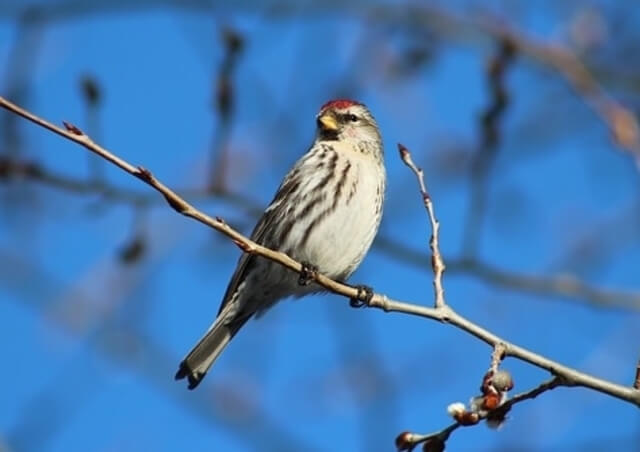
| Characteristic | Description |
|---|---|
| Identification | Common Redpolls are brown and white birds with white wingbars, a small red patch on the forehead, and dark feathers around their short yellow bill. Males have a reddish bib on the upper breast and upper flanks. |
| Length | 4.7-5.5 inches (12-14 cm) |
| Weight | 0.4-0.7 ounces (11-20 grams) |
| Wingspan | 7.5-8.7 inches (19-22 cm) |
The Common Redpoll is a small, typically found in the boreal forests of North America and Eurasia. They have been seen from Alaska to Labrador, throughout most of Canada’s territory, and down into parts of Scandinavia.
In winter, they migrate southwards to the taiga regions that stretch across Asia from Eastern Europe through Siberia. The redpolls live year-round near bogs or open country, where they feed on seeds from various types of plants.
Common Redpolls prefer to live in boreal forests but will sometimes venture into other types of habitat including mountain meadows, marshes, or coastal areas. Redpolls eat seeds from willow trees as well as other grains such as barley, oats, rye, wheat and triticale; they also eat insects (beetles), snails and spiders.
How to Attract Common Redpolls in Winter:
- Set up finch feeders with Nyjer seeds (thistle) and sunflower chips.
- Create sheltered areas using evergreen trees or shrubs.
Evening Grosbeak
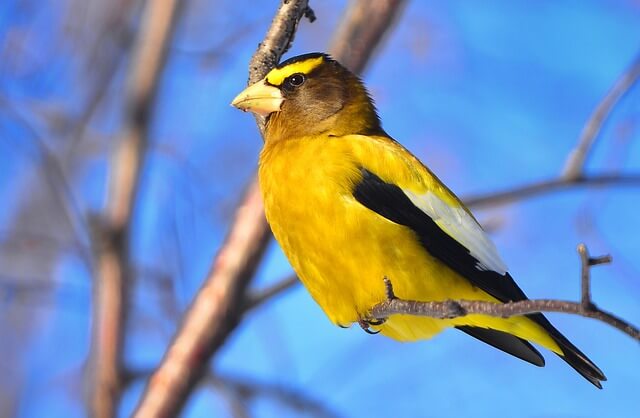
| Characteristic | Description |
|---|---|
| Identification | Males have a striking black and yellow plumage throughout, with brown heads accented by a bright yellow forehead. Females, on the other hand, display a grayish-brown plumage with a light yellow coloration at the neck. |
| Length | 6.3-7.1 inches (16-18 cm) |
| Weight | 1.9-2.6 ounces (53-74 grams) |
| Wingspan | 11.8-14.2 inches (30-36 cm) |
The Evening Grosbeak is a small bird that is a member of the finch family. These birds will occasionally show up to feeders in cold weather. They can be found in eastern North America from southern Ontario to Texas and north to the northern United States, but they can also be found as far south as Guatemala and Panama.
In North America, they typically live in deciduous forests or mixed woodlands that have a mixture of coniferous trees and broad-leafed plants for food sources. This bird feeds primarily on seeds such as those from weed flowers like dandelions, thistles, mullein, plantain and goldenrod.
It also eats insects during the summer months to provide protein for building up fat reserves for winter migrations southward or northward, depending on where they live.
How to Attract Evening Grosbeaks in Winter:
- Offer sunflower seeds, safflower seeds, and peanuts.
- Provide various feeder heights and perching spots.
Tufted Titmouse
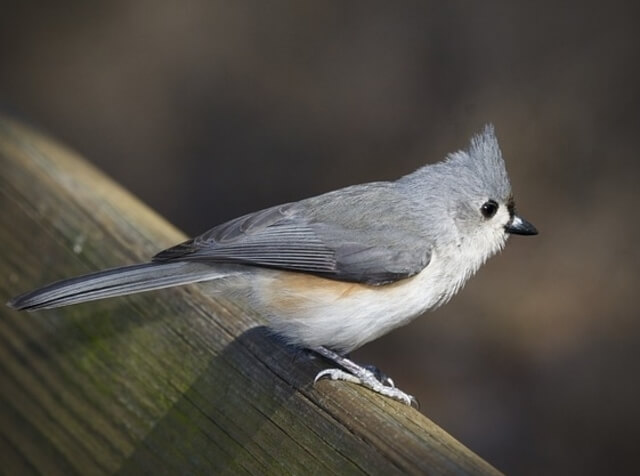
| Characteristic | Description |
|---|---|
| Identification | Tufted Titmice have a gray head with a tufted crest, a short stubby bill, white throat, breast, and belly, and a gray upper body outlined with rust-colored flanks. |
| Length | 5.5–6.3 inches (14–16 cm) |
| Weight | 0.6–0.9 ounces (17–26 grams) |
| Wingspan | 7.9–10.2 inches (20–26 cm) |
The Tufted Titmouse is a small songbird that can be found in North America. They are found from Eastern Canada to the Gulf Coast and as far west as Texas. They can be found as high up as 1300 meters (4265 feet) elevation on some mountain ranges such as the Appalachian Mountains.
Their habitat includes brushy edges of deciduous forests, woodlands, shrubby thickets, forest clearings, hedgerows and suburban gardens. This species prefers deciduous forests and open areas with low vegetation for its nesting sites, which it builds high up in trees or on ledges so they can see their surroundings easily.
They mainly eat insects such as ants, beetles and caterpillars but also will take berries, seeds and nuts. In winter, they often visit feeders for suet or seed mixes.
How to Attract Tufted Titmice in Winter:
- Use sunflower seeds, suet, and mealworms in hanging or pole-mounted feeders.
- Include evergreen trees or dense shrubs for cover.
Bohemian Waxwing
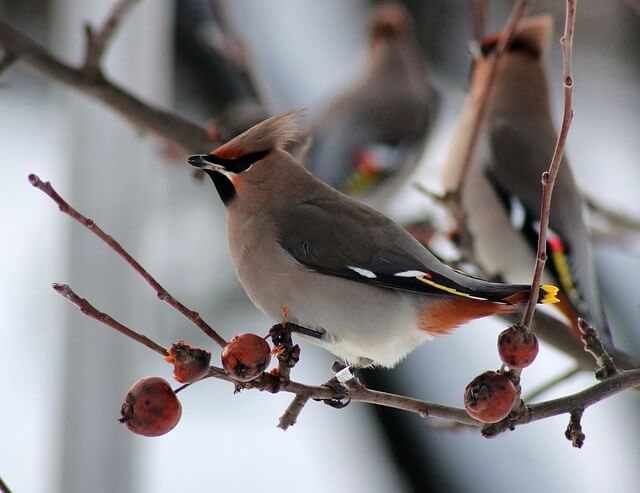
| Characteristic | Description |
|---|---|
| Identification | Mainly brownish-gray, with a large crest on its head. The male has cinnamon-colored areas on the face, a black mask, and a black throat. The breast and belly are a reddish-brown color. The back and tail are gray, with bright yellow tips. |
| Length | 7.5–9.1 inches (19–23 cm) |
| Weight | 1.9 ounces (55 grams) |
| Wingspan | 12.6–14.0 inches (32–35.5 cm) |
The Bohemian Waxwing is a medium-sized bird of the family Bombycillidae, and a winter visitor to the Northern Hemisphere. This migratory species breeds in northern North America, Europe, and Asia.
It winters primarily in southern Canada and the United States, from California to Virginia. This species of migratory bird can be found in habitats ranging from deciduous forests to tundra regions during the winter months when they are searching for food sources.
The birds have been known to eat berries from trees such as mountain ash, rowan, blackthorn and juniper berries. In order to find these berries they will travel distances of up to 600 miles per day looking for food sources.
Bohemian Waxwings are very common during their breeding season, as they build their nests high up on tall branches of trees or bushes.
How to Attract Bohemian Waxwings in Winter:
- Plant fruit-bearing trees or shrubs (crabapples, mountain ash).
- Set up a shallow birdbath with moving water.
Cedar Waxwing
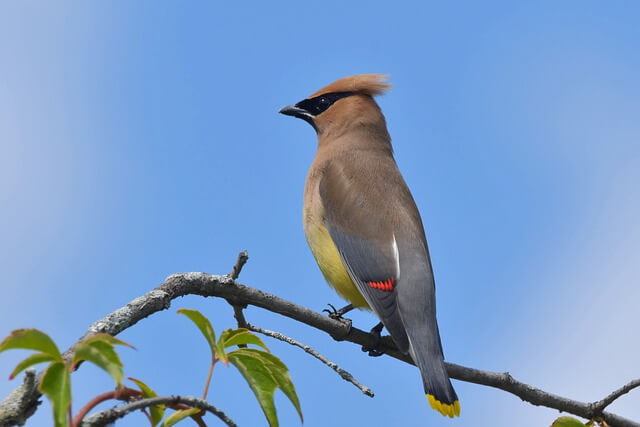
| Characteristic | Description |
|---|---|
| Identification | Cedar Waxwings can be easily identified by their large crest on top of their head, brown-gray plumage, black mask, and chin, with a pale yellow belly, yellow rump, and a bright red teardrop on each of the wings. The tip of their tail has a thick brilliant yellow stripe that is distinctive. |
| Length | 5.5–7.1 inches (14–18 cm) |
| Weight | 0.9-1.12 ounces (25-32 grams) |
| Wingspan | 8.5-12 inches (21.6-30.4 cm) |
The Cedar Waxwing is a medium-sized passerine bird in the family Bombycillidae. The range of this North American species extends from the southern United States to South America, including Mexico and Central America.
These birds live in northern climates, so they are used to snow and cold weather. Despite this, the waxwings must still find ways to keep themselves warm when it’s winter time. One way these birds do this is by hiding in dense vegetation or under trees during the day, then coming out at night to search for food.
In its wintering grounds, it can be found in tropical deciduous forests and semi-deciduous forests, but will also frequent mangrove swamps and suburban gardens with fruit trees.
Cedar Waxwings feed mainly on fruit like apple, persimmons and citrus, but also take insects as a protein source.
How to Attract Cedar Waxwings in Winter:
- Offer berries and fruits (cherries, grapes, serviceberries).
- Maintain a clean birdbath with fresh water.
Lapland Longspur
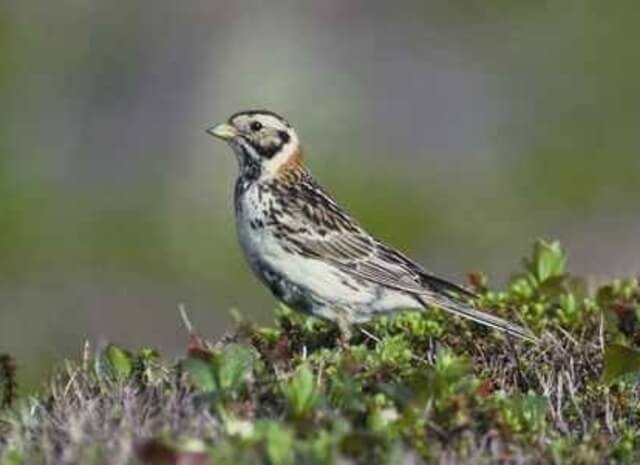
| Characteristic | Description |
|---|---|
| Identification | The winter plumage of Lapland Longspurs is a dull brown with some black streaking on the back and flanks, featuring a dark breast band, and a thick yellow seed-eater’s bill. |
| Length | 5.9-6.3 inches (15-16 cm) |
| Weight | 0.8-1.2 ounces (22.3-33.1 grams) |
| Wingspan | 8.7-11.4 inches (22-29 cm) |
The Lapland Longspur is a species of bird that can be found in the boreal forests and tundra regions of northern North America, Europe, and Asia. They are migratory birds with their breeding grounds in Scandinavia and Russia and their wintering grounds in western Canada.
The habitat of this species includes Arctic regions, northern boreal forests, prairies, mountainsides and near low-to-ground vegetation near water sources like lakes or streams.
These birds feed on insects such as beetles, butterflies, moths, flies, ants and other invertebrates during the summer months when they are not migrating, but change to seeds while at their wintering sites. They nest on the ground under protective vegetation like sedges or grasses.
How to Attract Lapland Longspurs in Winter:
- Scatter seeds (millet, cracked corn, oats) on open ground.
- Create open spaces and leave grasses uncut for cover.
Snowy Owl
| Characteristic | Description |
|---|---|
| Identification | Adults are snow-white, with three black bars on the tail feathers. Females have white plumage with barring and black spots throughout. Legs are feathered up to the toes, with black talons. Yellow eyes and a short downward-hooked beak. |
| Length | 20.5-28.0 inches (52-71.1 cm) |
| Weight | 56.5-104.1 ounces (3.5-6.5 pounds) |
| Wingspan | 49.2-57.1 inches (125-145 cm) |
The Snowy Owl is a large bird of prey in the family Strigidae family that lives throughout the northern hemisphere and breeds from Alaska, USA, Canada, Eurasia, Russia to Scandinavia. It has a circumpolar range which means it can be found anywhere in these areas.
They have been observed all over North America, from Alaska to Maine and from northern Canada to the southern United States. They live in both boreal forests and tundra environments, though they prefer open spaces with sparse vegetation where they can find their prey.
Snowy owls are primarily carnivorous birds that feed mainly on small mammals such as lemmings, voles, shrews and other rodents; they also eat hares, jackrabbits, weasels, squirrels, fish, reptiles (such as snakes), and small birds such as snow buntings and black duck. They will usually perch on trees or rocks during the day before going out at night to hunt.
How to Attract Snowy Owls in Winter:
- Snowy Owls are not typically attracted to feeders.
- Attracting smaller birds and rodents can indirectly lure Snowy Owls to your yard.
Northern Goshawk
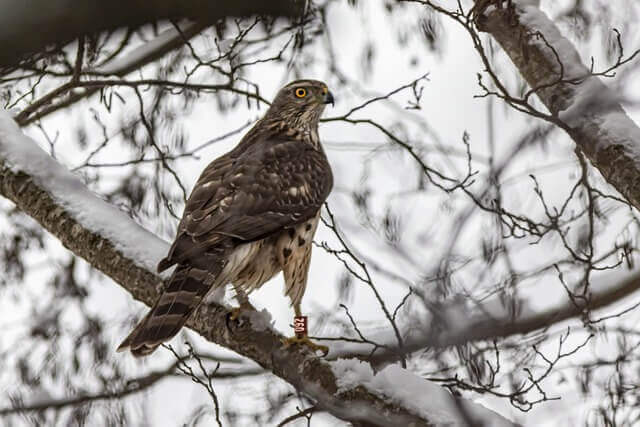
| Characteristic | Description |
|---|---|
| Identification | The Adult Goshawk has gray plumage on its back, and rump with light gray feathers on its chin, breast, abdomen, and legs, featuring dark horizontal barring. They have reddish-orange eyes with black irises and white eyebrow stripes. |
| Length | 1.75 – 2.1 feet (20.9-25.2 inches) |
| Weight | 6.6 – 13.0 pounds (22.3-48.1 ounces) |
| Wingspan | 3.4 – 3.8 feet (40.5-46.1 inches) |
Northern Goshawks are a large, forest-dwelling bird of prey that live in northern United States, Canada and Eurasia. They are commonly found throughout Canada and Alaska, as well as parts of Montana, Idaho, Washington, Oregon, California and Wyoming. They inhabit mainly coniferous forests and other habitats with lots of trees such as riparian areas, open fields, and coastal islands.
They are large birds with wingspans that can be up to 4 feet wide. They have long tails and strong, curved talons on their feet. These features make them excellent hunters as they fly through the air looking for prey below.
These birds hunt primarily during the day; their diet consists mostly of rodents, rabbits, squirrels, chipmunks and sometimes other small mammals like weasels or mice.
How to Attract Northern Goshawks in Winter:
- Northern Goshawks are not typically attracted to feeders.
- Attract smaller birds to your yard, which may indirectly attract Goshawks.
Attracting Birds to Your Yard in Winter
Winter can be a challenging time for birds as they search for food and shelter in cold weather. You can make your yard a welcoming haven for them by following these steps:
1. Provide Food
- Bird Feeders: Invest in bird feeders and fill them with a variety of bird seeds. Common seeds include sunflower seeds, millet, and cracked corn.
- Suet: Offer suet cakes or blocks, which are high-energy food sources, especially valuable during the winter months.
- Fruit: Hang up pieces of fruit, such as apples or oranges, to attract fruit-eating birds like robins and waxwings.
- Nectar: If you have hummingbirds in your area, keep a hummingbird feeder filled with sugar water (four parts water to one part sugar) available.
2. Water Source
- Ensure there is a heated bird bath or a heated water source for birds to drink from and bathe in. Water can be scarce in winter, and this can be a real draw for them.
3. Shelter
- Evergreen Trees and Shrubs: Plant evergreen trees and shrubs in your yard to provide natural shelter from harsh winds and cold temperatures.
- Birdhouses and Nesting Boxes: Install birdhouses and nesting boxes for birds to roost in overnight or use as shelter during extreme weather.
4. Native Plants
- Plant native shrubs, trees, and flowers in your garden. Native plants provide natural food sources and attract insects, which are essential for many bird species.
5. Cleanliness
- Regularly clean bird feeders and baths to prevent the spread of diseases. This is especially important in winter when birds may be more susceptible to illnesses.
6. Timing and Consistency
- Maintain a consistent feeding schedule. Birds rely on a steady food source during the winter months, so keep your feeders stocked.
7. Bird Identification
- Learn about the bird species in your area and their specific dietary preferences. This will help you tailor your offerings to attract a variety of birds.
8. Patience
- It may take some time for birds to discover your offerings. Be patient and persistent in your efforts to attract them to your yard.
By following these tips, you can create a winter haven for birds in your yard, helping them survive the cold months while enjoying the beauty of their presence.

